Colutea is a genus of about 25 species of deciduous flowering shrubs in the legume family Fabaceae, growing from 2–5 m tall, native to southern Europe, north Africa and southwest Asia. The leaves are pinnate and light green to glaucous grey-green. The flowers are yellow to orange, pea-shaped and produced in racemes throughout the summer. These are followed by the attractive inflated seed pods which change from pale green to red or copper in colour.
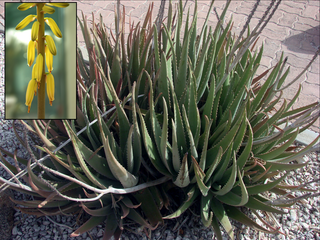
Aloe vera is a succulent plant species of the genus Aloe. An evergreen perennial, it originates from the Arabian Peninsula, but grows wild in tropical, semi-tropical, and arid climates around the world. It is cultivated for agricultural and medicinal uses. The species is also used for decorative purposes and grows successfully indoors as a potted plant.

Plantago major is a species of flowering plant in the plantain family Plantaginaceae. The plant is native to most of Europe and northern and central Asia, but has widely naturalised elsewhere in the world.
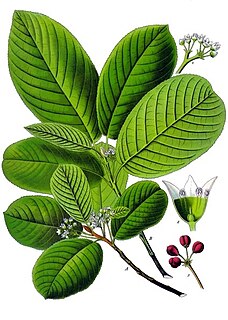
Rhamnus purshiana is a species of buckthorn native to western North America from southern British Columbia south to central California, and eastward to northwestern Montana.
James A. Duke was an American botanist. He was the author of numerous publications on botanical medicine, including the CRC Handbook of Medicinal Herbs. He was well known for his 1997 bestseller, The Green Pharmacy. He developed the Dr. Duke's Phytochemical and Ethnobotanical Databases at the USDA.

Hydrangea arborescens, commonly known as smooth hydrangea, wild hydrangea, or sevenbark, is a species of flowering plant in the family Hydrangeaceae. It is a small- to medium-sized, deciduous shrub up to 3 m (10 ft) tall that is native to the eastern United States.

Hydrangea cinerea, the ashy hydrangea or gray hydrangea, is a small to medium sized, deciduous shrub up to 3 m tall; its natural range is interior regions of the southeastern United States. Its common names reflect the ashy or gray appearance of the undersides of its leaves, which results from a dense pubescence.

Aloe arborescens is a species of flowering succulent perennial plant that belongs to the genus Aloe, which it shares with the well known and studied Aloe vera. The specific epithet arborescens means "tree-like". Aloe arborescens is valued by gardeners for its succulent green leaves, large vibrantly-colored flowers, winter blooming, and attraction for birds, bees, and butterflies.
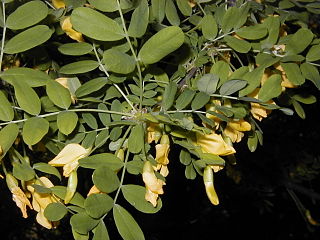
Caragana arborescens, the Siberian peashrub, Siberian pea-tree, or caragana, is a species of legume native to Siberia and parts of China and neighboring Mongolia and Kazakhstan. It was taken to the United States by Eurasian immigrants, who used it as a food source while travelling west. In some areas of the United States it is considered an invasive species.
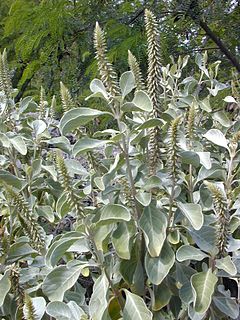
Achyranthes is a genus of medicinal and ornamental plants in the amaranth family, Amaranthaceae. Chaff flower is a common name for plants in this genus.
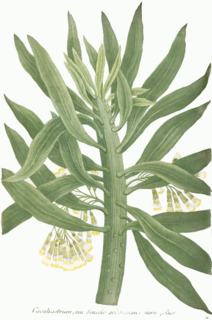
Senecio arborescens is a flowering plant in the aster family, but the available information about it is mostly conflicting and old.

Buchanania arborescens, commonly known as little gooseberry tree or sparrow's mango, is a small and slender tree native to monsoon forests of northern Australia, south-east Asia, and the Solomon Islands.

[ N.B. the monotypic genus Acnistus was subsumed in the genus Iochroma by J.M.H. Shaw in 2016 and the species formerly known as Acnistus arborescens is now known correctly as Iochroma arborescens (L.) J.M.H. Shaw ].

Psorothamnus arborescens is a species of flowering plant in the legume family known by the common name Mojave indigo bush.
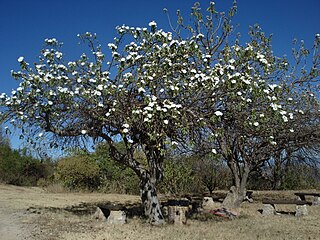
Ipomoea arborescens, the tree morning glory, is a flowering plant coming from the family Convolvulaceae. It grows fast and produces semi succulent stems. This tropical plant is mostly found in Mexico. It flowers in late autumn and winter. Its common name in Nahuatl is Cazahuatl or Cazahuate.

Lomatia arborescens, commonly known as smooth lomatia or tree lomatia, is a shrub or small tree that grows at high altitudes, in and near rainforests. It is found north from the Barrington Tops area in eastern Australia.

Artemisia arborescens, the tree wormwood, is a species of flowering plant in the family Asteraceae, native to the Mediterranean region. It is an erect evergreen perennial, with masses of finely-divided aromatic silvery-white leaves and single-sided sprays of yellow daisy-like flowers. This plant is cultivated for its foliage effects, but in colder temperate regions it requires the protection of a wall.
This is a list of plants used by the indigenous people of North America. For lists pertaining specifically to the Cherokee, Navajo, and Zuni, see Cherokee ethnobotany, Navajo ethnobotany, and Zuni ethnobotany.
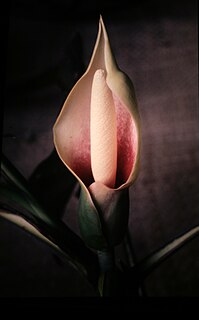
Montrichardia arborescens, the yautia madera, or moco-moco, is a tropical plant grows along river banks, swamps, or creeks to a maximum height of 9'. They consist of arrow shaped leaves that are food sources for animal species. The plant produces inflorescences which then leave a fruit of Montrichardia arborescens which is edible and can be cooked. Its fruiting spadices produces large infructescences, which contain about 80 edible yellow fruits.

Ambrosia peruviana is a species of plant in the family Asteraceae. It occurs from Mexico south to Argentina, being common in the Antilles and the Andes.

















